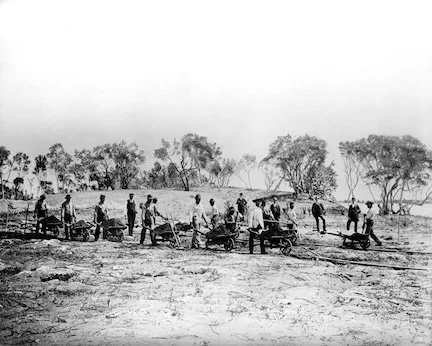Documenting the Emergence of a White Male Protestant Establishment
Thomas A. Tweed
October 16, 2025
Workers digging the foundation for the Royal Palm Hotel - Miami, Florida (1896).
Image RC03557. Courtesy of the State Archives of Florida.
“An Emerging Protestant Establishment,” a Church History article (Tweed, 1995), is a helpful early publication for considering “the present in retrospect.” I hoped to test the claims of religious historians who foregrounded the national rise and fall of the white mainline Protestant “establishment” and to nuance the analyses of urban historians who minimized religion as they chronicled changing power relations in cities that experienced sudden growth. Miami’s “founding” years (1896 to 1904) provided an apt case study to add to both scholarly conversations. So, focusing on a posed photograph of the first hotel’s ground-clearing, an image that would appear on promotional postcards, I excavated the layered meanings inscribed in that representation of the city’s origin. I concluded that a few members of marginalized groups did gain some public power in Miami’s first four years, but the temporary and limited egalitarianism failed to reach many others as a white male Protestant establishment began to solidify by 1900.
Although the article was anthologized in a volume commemorating the American Society of Church History ‘s centennial, it had less impact than other early publications like Our Lady of the Exile (Tweed, 1997) and Retelling US Religious History (ed. Tweed, 1997). Yet it might be helpful to revisit the piece because it anticipates the place-centered focus of my later work, including Religion in the Lands That Became America: A New History (Tweed, 2025), and, more important, it offers hints about how US religion specialists’ working conditions, historical sources, scholarly debates, and political stakes have changed—and not changed—in the past three decades.
Working Conditions
The everyday conditions for conducting research have changed as information and communication technologies and universities’ external pressures and hiring practices have changed. When I started researching the article in 1991, electronic mail had not reached campuses, religious groups did not have web pages, and digitized archival sources were not available. Research for this piece involved pulling city directories off library shelves, scrolling newspapers on microfilm, traveling to archival collections, and visiting congregations to seek evidence that might fill gaps in the documentary record. I spent considerable time doing the offline historical research for Table 1, “Biographical Profile of Selected White Leaders,” for instance, but, with online resources, today I might be able to create those profiles in a week. Younger researchers might note the differences and generously recalibrate their assessments of earlier scholarship; older scholars might resist self-elevating hardship stories and, most important, acknowledge unspoken advantages. During the Nineties, those with tenure-track positions and reasonable teaching loads had the time and resources to nerd-out on slow research. Today state legislators challenge the tenure system, and some colleges and universities are replacing full-time positions with less secure jobs that provide neither research support nor a living wage.
Historical Sources
The historic photograph, which I found in an archive and which Church History eventually agreed to include, initially was an obstacle to publication. Today the journal’s editors tell contributors that “black-and-white illustrations…are welcome.” That was not the case when I submitted the article. The journal accepted it but asked that I cut the photograph. They did not allow images. Even though my tenure decision loomed, I said that the image was crucial for my argument and if they couldn’t include it, I would have to reluctantly withdraw my submission. Before I had time to regret the decision, the kind editor consulted the publisher and broke with tradition. I was deeply grateful, but the journal’s initial reluctance surfaces another difference between then and now: thanks to the influence of works like Material Christianity (McDannell, 1998), published in the same year as my article, and The Visual Culture of American Religions (eds. Promey and Morgan, 2001), which appeared a few years later, the range of acceptable sources widened considerably by the twenty-first century.
With later volumes like Digging Miami (Carr, 2023) and New Histories of Pre-Columbian Florida (ed. Wallis and Randall, 2014), the sources on Indigenous history also expanded, and that research recontextualizes the 1890s photograph and remaps the ancient landscape. We now know more about the burial mound that was tragically destroyed when workers built the Royal Palm Hotel. That mound, which was about 15 feet high and 150 feet long, had been the largest of several mounds near the mouth of the Miami River. Beneath and near the hotel’s foundations, surprised archaeologists found an intact cemetery dating back at least two thousand years. Just as surprising, an architectural feature they named for the hotel, “Royal Palm Circle,” also survived the ground-clearing and construction: archaeologists found the post holes of a circular building constructed about 700 CE. So, the landscape depicted in the photograph once included a special building (maybe a council house, chief’s house, or temple) as well as that 150-feet long burial mound.[1]
Scholarly Debates
For me, the updated information about the Tequesta symbolic landscape makes the ground-clearing photograph even more heartbreaking, and I would expand my account if I were writing it today by incorporating the archaeological findings and consulting Indigenous communities. Seven years before uncovering that circular structure’s imprint in 2005, archaeologists found the Miami Circle, an older but similar ceremonial space on the other side of the Miami River, and Native Nations with ancestral ties to the Southeast quickly passed a resolution declaring it a sacred site. In turn, if I were writing the piece today, I would hope to add Indigenous interpretations of the Royal Palm Circle, the burial mound, and the posed photograph.
Some terms, like “urban frontier,” seem less helpful now, and few scholars debate “consensus” and “conflict” models. However, the piece raised questions about the origins of white Protestant power that still seem relevant. Some historians during the 1990s were insisting that comprehensive narratives must center clergy in the pulpits of mainline Protestant churches, a claim our Retelling project was preparing to challenge. And historical memory now seems even more contested, as the president issues executive orders to “restore truth to American history,” and historians counter with condemnations of the “federal censorship of American history”?
Political Stakes
There was some surveillance of faculty research and course syllabi in earlier decades, though the political stakes for those who teach and write about the US are higher today. When I taught at state universities between 1993 and 2013 unenrolled students sent by conservative groups to document what faculty taught attended a few class lectures. The climate got chillier by spring 2013, when a conservative group published an assessment of faculty publications and reading assignments at my public university. Their report, Recasting History, recommended, for example, that graduate programs avoid privileging “race, class, and gender” and that faculty assign key documents, like the Mayflower Compact, to “depoliticize history.” A few of the recommendations seemed reasonable—“keep broad courses broad”—but, overall, the report was alarming. Recent efforts to “recast” US history are even more alarming because they have the enforcing power of the government behind them, and the guardians of national memory, including universities, libraries, and museums, have been pressured to erase facts that don’t fit the sanctioned story. In this sense, the political stakes for those dedicated to faithfully recovering the full complexity of America’s religious past have never been higher.
[1] The information in this paragraph can be found in Carr, Digging Miami, 7-10, 87-88, 103, 238-240. On the “Miami Circle,” the uncovered footprints of an older but similar circular structure, see pp. 233-248.

